July 30, 2020 — NASA's first Mars mission devoted to searching for and caching signs of life for a future return to Earth is now on its way to the Red Planet.
The U.S. space agency's Mars 2020 mission, which includes a six-wheeled rover named "Perseverance" and a small helicopter called "Ingenuity," lifted off atop a United Launch Alliance (ULA) Atlas V rocket from Complex 41 at Cape Canaveral Air Force Station in Florida on Thursday (July 30).
The 7:50 a.m. EDT (1150 GMT) launch began the mission's seven-month, 300 million-mile (480 million-kilometer) journey to Mars, which will culminate in the so-called "seven minutes of terror," otherwise known as entry, descent and landing, on Feb. 18, 2021, into Jezero Crater located on the western edge of a giant impact basin just north of the planet's equator.
"The most exciting part is to go land in this [ancient, dried-up] river delta that we think has so many promising landscapes and kinds of rocks that, in fact, we don't only want to see pictures of and take measurements of, [but] we want to see back in the best labs that are available to humanity, which is of course on Earth, with Mars sample return being a reality," said Thomas Zurbuchen, the head of NASA's science division, in a pre-launch press briefing.
Perseverance is NASA's most complex rover to date and, if successful, will be its ninth mission to land on Mars and fifth to rove the Martian surface in the 45 years that the U.S. has been sending spacecraft to the planet. It is also the first NASA mission to test technologies that will advance the day that humans walk on Mars and the first to be devoted to finding evidence of microbial life.
"This is the first time in history when NASA has dedicated a mission to what we call astrobiology, the search for life, either maybe now or ancient life, on another world," said NASA Administrator Jim Bridenstine. "That river delta [in Jezero Crater] is a place that we believe there could be — not saying there is, we don't know, but there could have been at one point in time — life."
Search, sample and stash
Similar in appearance to NASA's Curiosity rover, which landed in August 2012 and remains active today in Mars' Gale Crater, Perseverance is about 5 inches (3 centimeters) longer and 278 pounds (126 kilograms) heavier than its predecessor. It will employ the same basic method for entry, descent and landing, involving an aeroshell, parachute, retro-rockets and "sky crane," but will be able to see where it is touching down using seven cameras and adjust accordingly to avoid hazards on the way into Jezero Crater.
Perseverance also features upgraded wheels, a more sophisticated, self-driving navigation system and will deploy the small Ingenuity helicopter, which will attempt humanity's first powered flight on another planet.
The rover, which is powered by a radioisotope thermoelectric generator (RTG), is designed to operate for a nominal mission of one Mars year (687 Earth days). It will use that time to search for organic-rich geological samples, which it will then collect in test-tube-like canisters to leave on Mars' surface for a future mission to come get and return to Earth by 2031.
To identify the samples, Perseverance has two science instruments, SHERLOC (Scanning Habitable Environments with Raman & Luminescence for Organics & Chemicals) and PIXL (Planetary Instrument for X-ray Lithochemistry), mounted to the end of its 7-foot-long (2.1-meter) robotic arm.
"What they do is they allow us to combine or co-register in a single, postage-stamp-size area the things that you could see with your eyes, like color and texture, but also chemistry and mineralogy," said Ken Farley, the mission's project scientist at Caltech in Pasadena, California. "This is a very powerful combination that's never been done before on Mars. It will allow us to understand how rocks formed, what their history has been since they formed and, in particular, it is one of the key ways that we will look for evidence of life, for what we call biosignatures."
Once a target is selected, a multi-bit drill will be used to collect a core or regolith (soil) sample, which will then be transferred into one of the tubes to be cached on the surface.
"[These tubes are] amongst the cleanest things that have ever been built — certainly the cleanest thing that has ever been flown — in the sense that the inside of these tubes, of which there are 43 on board the rover, has no microbes and is extremely clean of organic matter. That's necessary so that when they come back to Earth, we can be certain that what's inside the tubes actually came from Mars and didn't come from Earth," said Farley.
The chosen samples will represent habitable environments and provide scientists with more information about the climate and past geology of Mars, in addition to potential biosignatures.
"What we are looking for is likely very primitive life. We are not looking for advanced life forms that might leave things like bones or fern fossils or something like that. We are looking, by analogy, to what we find in a similar time on Earth, microbial life," Farley said.
Along for the ride
"The Mars 2020 mission has three major goals. The first is to seek signs of life. The second is to collect and cache a suite of samples that a future mission could bring back to Earth. And the third is to test technologies that future explorers of Mars, either robotic or possibly even human, could take advantage of," explained Farley.
In support of that third goal, the rover is carrying spacesuit material swatches to see how they fare when exposed to the Martian environment for a long period of time and has a proof-of-concept experiment to produce oxygen from the carbon dioxide rich-atmosphere. MOXIE (Mars Oxygen In-Situ Resource Utilization Experiment), which is about the size of a car battery, will demonstrate that future astronaut explorers can produce the oxygen needed to breath and produce rocket propellant rather than having to transport the consumable all the way from Earth.
Perseverance is also taking humans along for the ride, virtually and symbolically.
The rover is outfitted with nine engineering cameras and seven science cameras (In addition to the seven cameras used for the entry, descent and landing), as well as the first microphones to be flown to Mars, which will share both the sights and sounds of what it encounters.
Perseverance also has a metal plate mounted to its left rear that is a tribute to the people who had to persevere while the mission was being readied for launch and who inspired the rover's team to keep going.
"We call the plate the 'Perseverance COVID-19 plate," said Matt Wallace, the mission's deputy project manager at NASA's Jet Propulsion Laboratory (JPL). "[The plate has] a representation of the Earth on the top to symbolize the challenge that we faced globally as the pandemic struck. We have a representation fo the spacecraft leaving the Earth and heading to Mars. And, all of this is appropriately supported by the rod and serpent of the medical community."
Another etched aluminum plate affixed to the center of the rover's aft crossbeam carries three fingernail-sized silicon chips bearing the names of 10,932,295 people who signed up to "Send Your Name to Mars." One of the chips also includes the essays of the 155 finalists in NASA's "Name the Rover" contest.
"On the plate [is] a representation of the solar system with Earth and Mars and there is some hidden Morse code in the rays of the Sun, which people quickly recognized spelled out 'Explore As One' — which is what we intend to do," said Wallace. "We are looking forward to having everybody come along for the ride." |
|
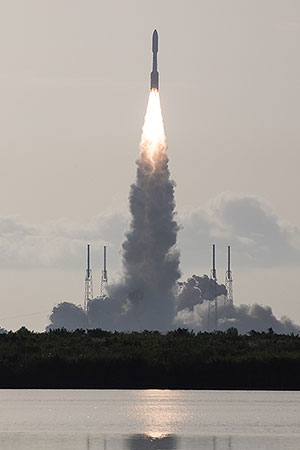
A United Launch Alliance (ULA) Atlas V rocket lifts off with NASA's Perseverance Mars rover from Complex 41 at Cape Canaveral Air Force Station in Florida, on July 30, 2020. (NASA/Joel Kowsky)
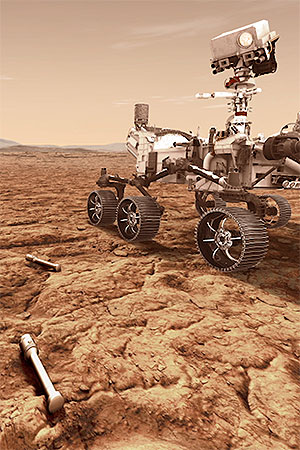
Artist illustration of NASA's Perseverance rover with sample return cache tubes on the Martian surface. (NASA-JPL/Caltech)
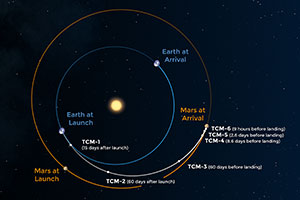
Illustration of the route the Mars 2020 spacecraft takes to the Red Planet, including several trajectory correction maneuvers (TCMs) to adjust its flight path. (NASA-JPL/Caltech)
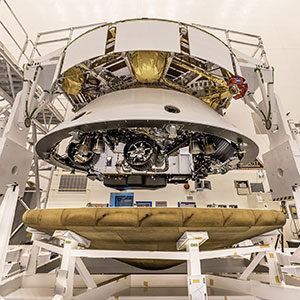
The Mars 2020 backshell-powered descent vehicle and entry vehicle assemblies are attached to the Perseverance rover at NASA Kennedy Space Center, Florida. (NASA/Christian Mangano)
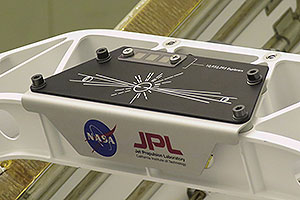
A plate for NASA's "Send Your Name to Mars" campaign installed on the Perseverance rover with three fingernail-sized chips etched with 10,932,295 names. (NASA/JPL-Caltech) |
